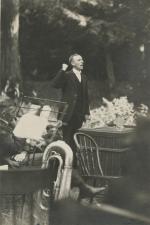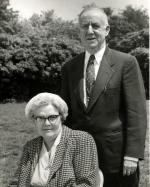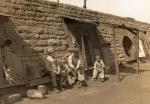![header=[Marker Text] body=[The American labor leader lived here in Nanty Glo. Brophy was president of District 2, United Mine Workers of America, 1916-1926; he gained national prominence for his "Miner's Program," calling for a shorter work week, nationalization of the mines, and a labor party. An official of the Congress of Industrial Organizations (CIO), 1935-1961, Brophy was a longtime advocate for a democratic labor movement] sign](http://explorepahistory.com/kora/files/1/10/1-A-2C8-139-ExplorePAHistory-a0k3i4-a_450.jpg)
Mouse over for marker text
Name:
John Brophy
Region:
Laurel Highlands/Southern Alleghenies
County:
Cambria
Marker Location:
Triangle Park, Route 271
Dedication Date:
November 6, 1993
Behind the Marker
-John Brophy, from John Brophy, A Miner's Life, 1964.
Born in Lancashire, England in 1883, Brophy was nine years old when his father moved the family to central Pennsylvania and just eleven when he joined his father in the mines. After joining the United Mine Workers of America (UMWA) as a teenager he rose through the ranks of organized labor to become the first executive director of the Committee for Industrial Organization (CIO) during its first great organizing campaigns of the mid-1930s.
Elected president of UMWA District 2, which covered bituminous mines in southwestern Pennsylvania, in 1916, Brophy rose to national prominence when he led a campaign within the UMWA for nationalization of the coal industry. In 1921, Brophy introduced "The Miners' Program," arguing that a thirty-hour week, worker control of the industry, and nationalization of the mines under the federal government would unify the industry, improve its management, and thus reduce the cost of coal to consumers at the same time that it provided miners a decent living. Brophy's support of nationalization soon brought him into conflict with the UMWA's charismatic and powerful president John L. Lewis.
In 1919, a national coal strike led by the UMWA won substantial pay raises for miners, but when the contract expired in 1922, mine owners sought to reduce wages to meet the costs of rising competition. In response, Lewis called for a national strike in April. Recognizing that the key to the strike's success would be participation of workers in non-union mines, Brophy, with Lewis's blessing, focused on organizing the 90,000 non-union miners in the coal fields of western Pennsylvania.
Within weeks, all of Pennsylvania's coal mines were shut down tight for the first time in state history. In response, coal operators evicted workers by the thousands from housing in Windber and other company towns, who then lived for months in union-provided tents and barracks. The operators also used company guards to beat and
Windber and other company towns, who then lived for months in union-provided tents and barracks. The operators also used company guards to beat and  intimate striking workers and their families. The strike dragged on for sixteen long months, before Lewis and the coal operators, under pressure from President Warren G. Harding, agreed to a new contract that preserved earlier gains for union miners, but left out nearly 70,000 nonunion miners who had struck, including those in District 2.
intimate striking workers and their families. The strike dragged on for sixteen long months, before Lewis and the coal operators, under pressure from President Warren G. Harding, agreed to a new contract that preserved earlier gains for union miners, but left out nearly 70,000 nonunion miners who had struck, including those in District 2.
Furious with Lewis for abandoning the non-union strikers, Brophy resigned from the UMWA's Nationalization Research Committee and watched helplessly as an industry-wide crisis caused by overproduction resulted in the closing of high-wage mines in unionized areas of Pennsylvania and other northern states, and increased production at low-wage, non-union mines in southern states.
Alarmed by Lewis's personal ambition and increasingly ruthless suppression of union democracy, Brophy and other UMWA leaders organized a "Save the Union" campaign that challenged Lewis for control of the union. In 1926 Brophy ran unsuccessfully against Lewis for the UMWA presidency, then challenged the election results with documented evidence of voter fraud. In response, Lewis banned Brophy from the UMWA.
Brophy would remain outside the American labor movement for the next seven years, during which time he traveled to Europe and the Soviet Union, ran a small labor school, worked as a salesman, and committed himself to an ambitious program of self education.
After the onset of the Great Depression, the mining industry in Pennsylvania went into a free fall. In three years, the production of bituminous coal fell from 144m to 75m tons. Bitter strikes and violence soon flared, and forced Governor Gifford Pinchot in 1933 to send the Pennsylvania National Guard to help maintain the peace during a futile strike of more than 70,000 bituminous miners.
Governor Gifford Pinchot in 1933 to send the Pennsylvania National Guard to help maintain the peace during a futile strike of more than 70,000 bituminous miners.
In the early 1930s Brophy returned to Nanty Glo to organize miners. After passage of the National Industrial Recovery Act (NIRA) in 1933, which sanctioned collective bargaining, John L. Lewis brought Brophy back into the UMWA to study the conditions of the mining in Pennsylvania and other states, and to help with new organizing campaigns, which pushed membership to about 400,000 in 1934.
Convinced that American workers in steel, automobiles, rubber, and other nonunion industries must be organized in industrial unions that crossed craft divides, Lewis, Brophy, and leaders of other national unions in 1935 organized the Committee for Industrial Organization (CIO). Appointed the CIO's first executive director, Brophy then helped supervise the first great CIO strike at the Goodyear plant in Akron, Ohio, in February 1936, and the first sit-down strikes of autoworkers in Flint, Michigan, and elsewhere.
Committee for Industrial Organization (CIO). Appointed the CIO's first executive director, Brophy then helped supervise the first great CIO strike at the Goodyear plant in Akron, Ohio, in February 1936, and the first sit-down strikes of autoworkers in Flint, Michigan, and elsewhere.
In 1940, Lewis and Brophy again came into open conflict, and Lewis attempted to expel Brophy from the CIO for his support of FDR's run for a third term as president, which Lewis opposed. In 1941, however, Lewis lost the CIO presidency to Philip Murray, another western Pennsylvanian, who like Brophy, had risen through the ranks of the UMWA in the early 1900s.
Reassigned as the Director of Councils, Brophy played an important role in the CIO's expulsion of Communist Party led unions after the end of World War II, and worked to solidify CIO control over local labor councils and state bodies. After the merger of the CIO with the AFL in 1955, Brophy continued to work in the national office, serve on the Advisory Committee on Civil Defense Administration for the United States Department of Labor, and work on his autobiography, published as John Brophy: Miner's Life, the year after his death in 1963.
"I wanted social justice, and a more efficient economy free of the ups and downs of the business cycle. I wanted union labor participation in the basic decisions of industry. Above all, I was bitter against conditions in the coal industry, with its frightful waste of men and resources, killing two thousand and injuring tens of thousands of men every year."
-John Brophy, from John Brophy, A Miner's Life, 1964.
Born in Lancashire, England in 1883, Brophy was nine years old when his father moved the family to central Pennsylvania and just eleven when he joined his father in the mines. After joining the United Mine Workers of America (UMWA) as a teenager he rose through the ranks of organized labor to become the first executive director of the Committee for Industrial Organization (CIO) during its first great organizing campaigns of the mid-1930s.
Elected president of UMWA District 2, which covered bituminous mines in southwestern Pennsylvania, in 1916, Brophy rose to national prominence when he led a campaign within the UMWA for nationalization of the coal industry. In 1921, Brophy introduced "The Miners' Program," arguing that a thirty-hour week, worker control of the industry, and nationalization of the mines under the federal government would unify the industry, improve its management, and thus reduce the cost of coal to consumers at the same time that it provided miners a decent living. Brophy's support of nationalization soon brought him into conflict with the UMWA's charismatic and powerful president John L. Lewis.
In 1919, a national coal strike led by the UMWA won substantial pay raises for miners, but when the contract expired in 1922, mine owners sought to reduce wages to meet the costs of rising competition. In response, Lewis called for a national strike in April. Recognizing that the key to the strike's success would be participation of workers in non-union mines, Brophy, with Lewis's blessing, focused on organizing the 90,000 non-union miners in the coal fields of western Pennsylvania.
Within weeks, all of Pennsylvania's coal mines were shut down tight for the first time in state history. In response, coal operators evicted workers by the thousands from housing in
Furious with Lewis for abandoning the non-union strikers, Brophy resigned from the UMWA's Nationalization Research Committee and watched helplessly as an industry-wide crisis caused by overproduction resulted in the closing of high-wage mines in unionized areas of Pennsylvania and other northern states, and increased production at low-wage, non-union mines in southern states.
Alarmed by Lewis's personal ambition and increasingly ruthless suppression of union democracy, Brophy and other UMWA leaders organized a "Save the Union" campaign that challenged Lewis for control of the union. In 1926 Brophy ran unsuccessfully against Lewis for the UMWA presidency, then challenged the election results with documented evidence of voter fraud. In response, Lewis banned Brophy from the UMWA.
Brophy would remain outside the American labor movement for the next seven years, during which time he traveled to Europe and the Soviet Union, ran a small labor school, worked as a salesman, and committed himself to an ambitious program of self education.
After the onset of the Great Depression, the mining industry in Pennsylvania went into a free fall. In three years, the production of bituminous coal fell from 144m to 75m tons. Bitter strikes and violence soon flared, and forced
In the early 1930s Brophy returned to Nanty Glo to organize miners. After passage of the National Industrial Recovery Act (NIRA) in 1933, which sanctioned collective bargaining, John L. Lewis brought Brophy back into the UMWA to study the conditions of the mining in Pennsylvania and other states, and to help with new organizing campaigns, which pushed membership to about 400,000 in 1934.
Convinced that American workers in steel, automobiles, rubber, and other nonunion industries must be organized in industrial unions that crossed craft divides, Lewis, Brophy, and leaders of other national unions in 1935 organized the
In 1940, Lewis and Brophy again came into open conflict, and Lewis attempted to expel Brophy from the CIO for his support of FDR's run for a third term as president, which Lewis opposed. In 1941, however, Lewis lost the CIO presidency to Philip Murray, another western Pennsylvanian, who like Brophy, had risen through the ranks of the UMWA in the early 1900s.
Reassigned as the Director of Councils, Brophy played an important role in the CIO's expulsion of Communist Party led unions after the end of World War II, and worked to solidify CIO control over local labor councils and state bodies. After the merger of the CIO with the AFL in 1955, Brophy continued to work in the national office, serve on the Advisory Committee on Civil Defense Administration for the United States Department of Labor, and work on his autobiography, published as John Brophy: Miner's Life, the year after his death in 1963.










